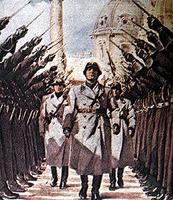| Monday, November 15, 2004 |  |
|
|
|
Well, I've mentioned this kind of thing before. And now we can test it on you. Here's a video. It is a 7MB java thing, so it will take a little while to load. And here are the instructions: You are only allowed to watch it once. Seriously, do not cheat! In the video you will see a group of basketball players, some in white and some in black passing two balls around. Your goal is to count how many times the ball is passed by those wearing white shirts. It’s that simple. Remember, count just the passes of the ball by those wearing white. Once the movie is over, write down the number of passes you have counted. And, once you've done that, go on to step two. That's all I can say. Watch the white players, count the passes of the ball, and go on to the page where you can see how well you did. (via MetaFilter)
[ Patterns | 2004-11-15 02:07 | | PermaLink ] More >
|
|
|
|
 Via Bird on the Moon, this is an abstract from an article, Omega Zero; The Influence of the Future on Cosmic Evolution: Via Bird on the Moon, this is an abstract from an article, Omega Zero; The Influence of the Future on Cosmic Evolution: In considering the recent discovery that cosmological expansion is accelerating toward the extreme physics of absolute zero, science is understandably at a loss for conceptual representation of the distant future. Cosmology is in an unprecedented adjustment period since the absolute zero future we are being forced to consider was previously ruled impossible. Part one of this essay considers the consequences of admitting absolute zero as a possible state in the partition of states considered available to the evolution of space-time, and considers reasons why reaching zero might be the overall objective of time. In investigating the role of zero within the set of all possible states we recognize that if the direction of time is indeed aimed at zero, then the second law of thermodynamics is too simple to explain time’s arrow. Part two, in considering how an absolute zero state fits into an order-disorder gradient, proposes the central theme of the paper, a theory that there are two opposing types of order present in nature, rather than simply order and disorder, a step which directly challenges the second law in a general way not considered previously. The concrete discovery of two orders resolves into focus a major conceptual shift first advocated in western science by physicist David Bohm. It exposes a supreme state in physical reality and leads to a teleological model of cosmological and biological evolution. In support of this shift, part three presents a surprising switch in mathematical modality, what one reader referred to as God’s math, where positive and negative numbers, or matter and anti-matter, are understood to combine rather than cancel, making absolute zero a unified whole value, rather than nothing. This essay introduces several valuable and highly thought provoking fundamental concepts which, like the anthropic principle prior to 1974, have not yet been explored in mainstream science. Can't say I exactly get it, but count me in.
[ Science | 2004-11-15 02:07 | 0 comments | PermaLink ]
|
|
|
|
 Dr. Lawrence Britt has examined the fascist regimes of Hitler (Germany), Mussolini (Italy), Franco (Spain), Suharto (Indonesia) and several Latin American regimes. He found 14 defining characteristics common to each: Dr. Lawrence Britt has examined the fascist regimes of Hitler (Germany), Mussolini (Italy), Franco (Spain), Suharto (Indonesia) and several Latin American regimes. He found 14 defining characteristics common to each:1. Powerful and Continuing Nationalism - Fascist regimes tend to make constant use of patriotic mottos, slogans, symbols, songs, and other paraphernalia. Flags are seen everywhere, as are flag symbols on clothing and in public displays.
2. Disdain for the Recognition of Human Rights - Because of fear of enemies and the need for security, the people in fascist regimes are persuaded that human rights can be ignored in certain cases because of "need." The people tend to look the other way or even approve of torture, summary executions, assassinations, long incarcerations of prisoners, etc.
3. Identification of Enemies/Scapegoats as a Unifying Cause - The people are rallied into a unifying patriotic frenzy over the need to eliminate a perceived common threat or foe: racial , ethnic or religious minorities; liberals; communists; socialists, terrorists, etc.
4. Supremacy of the Military - Even when there are widespread
domestic problems, the military is given a disproportionate amount of government funding, and the domestic agenda is neglected. Soldiers and military service are glamorized.
5. Rampant Sexism - The governments of fascist nations tend to be almost exclusively male-dominated. Under fascist regimes, traditional gender roles are made more rigid. Divorce, abortion and homosexuality are suppressed and the state is represented as the ultimate guardian of the family institution.
6. Controlled Mass Media - Sometimes to media is directly controlled by the government, but in other cases, the media is indirectly controlled by government regulation, or sympathetic media spokespeople and executives. Censorship, especially in war time, is very common.
7. Obsession with National Security - Fear is used as a motivational tool by the government over the masses.
8. Religion and Government are Intertwined - Governments in fascist nations tend to use the most common religion in the nation as a tool to manipulate public opinion. Religious rhetoric and terminology is common from government leaders, even when the major tenets of the religion are diametrically opposed to the government's policies or actions.
9. Corporate Power is Protected - The industrial and business aristocracy of a fascist nation often are the ones who put the government leaders into power, creating a mutually beneficial business/government relationship and power elite.
10. Labor Power is Suppressed - Because the organizing power of labor is the only real threat to a fascist government, labor unions are either eliminated entirely, or are severely suppressed.
11. Disdain for Intellectuals and the Arts - Fascist nations tend to promote and tolerate open hostility to higher education, and academia. It is not uncommon for professors and other academics to be censored or even arrested. Free expression in the arts and letters is openly attacked.
12. Obsession with Crime and Punishment - Under fascist regimes, the police are given almost limitless power to enforce laws. The people are often willing to overlook police abuses and even forego civil liberties in the name of patriotism. There is often a national police force with virtually unlimited power in fascist nations.
13. Rampant Cronyism and Corruption - Fascist regimes almost always are governed by groups of friends and associates who appoint each other to government positions and use governmental power and authority to protect their friends from accountability. It is not uncommon in fascist regimes for national resources and even treasures to be appropriated or even outright stolen by government leaders.
14. Fraudulent Elections - Sometimes elections in fascist nations are a complete sham. Other times elections are manipulated by smear campaigns against or even assassination of opposition candidates, use of legislation to control voting numbers or political district boundaries, and manipulation of the media. Fascist nations also typically use their judiciaries to manipulate or control elections.
Hm, reminds me of something. Can't quite put my finger on it.
[ Politics | 2004-11-15 02:08 | | PermaLink ] More >
|
|
|
|
 A little history lesson from Ben Hammersley: A little history lesson from Ben Hammersley:As solace, or a warning, I give you history from around five hundred and ten years ago, here in Florence. After the city had seen a period of intense financial growth and the blossoming of art, philosophy and literature - and a period of international influence and real financial power stretching from London to Jerusalem, which is about as far as a European could stretch in those days - a small, but vocal, minority started to talk about the sinfulness of the local society: the lax morals; the frivilous civilisation; the unchristian corruption of the leaders; their preference of idolatrous and, frankly, homoerotic art. It was, they said, time to get back to basics. To real Christian values.
Their leader, Girolamo Savonarola, preached hellfire and damnation and roused the crowds into rejecting the old ways. Groups were formed, going door to door to punish gamblers, drinkers, women dressed in too immodest clothing and other such outrages to their beliefs. Artworks, books, playing cards, ornaments, and all the other symbols and tools of the more liberal citizens were seized, and publicly burnt in the middle of the main square - the Bonfire of the Vanities.
The crowds, the less educated, the less worldly, loved all of this. Savonarola’s passion and beliefs chimed with them, even as they watched their city’s treasures destroyed - It was about time someone put those intellectuals in their place, and God in his.
But after a while, and here is the catch, dear reader, it all got too much. Spurred on by his initial success, Savonarola grew increasingly extreme in his views. Unchecked by the need to gain support, he pushed and pushed, until, eight years after he had first appeared in Florence, the crowd rebelled once more and he was hanged and burnt on the same spot of the Bonfires of the Vanities.
Today that spot is marked with a bronze plaque, barely noticed by the people walking over it on their way into the Uffizi Gallery - a building founded years later by the very same intellectuals that Savonarola had temporarily replaced, to house the masterpieces he had so despised.
I guess fanatics tend to go too far. And you don't stop renaissances all that easily.
[ History | 2004-11-15 21:58 | | PermaLink ] More >
|
|
|
|
 From Kuro5hin article From Kuro5hin article Tensegrity is a term used in architecture.
What is tensegrity?
“The word ‘tensegrity’ is an invention: a contraction of ‘tensional integrity’. Tensegrity describes a structural-relationship principle in which structural shape is guaranteed by the finitely closed, comprehensively continuous, tensional behaviors of the system and not by the discontinuous and exclusively local compressional member behaviors. Tensegrity provides the ability to yield increasingly without ultimately breaking or coming asunder”
Richard Buckminster Fuller (excerpt from Synergetics, p. 372.)
The tension of the different parts of the structure gives the structure its strength. Separately each part is a burden on the structure. Together the parts make the structure strong.
Tensegrity structures are distinguished by the way forces are distributed within them. The members of a tensegrity structure are either always in tension or always in compression.
The United States has a similar tensegrity. Yeah, hm, I guess. But not nearly as well as it used to, or as well as it could. And not as much at this particular time. However, the author does a nice job of outlining how different elements in society sort of push against each other, to create a more stable system overall.
But you spoil the tensegrity if you put too many things in one hat, or make things too one sided. There needs to be a certain equilibrium.
[ Organization | 2004-11-15 22:06 | | PermaLink ] More >
|
|
 Via Bird on the Moon, this is an abstract from an article, Omega Zero; The Influence of the Future on Cosmic Evolution:
Via Bird on the Moon, this is an abstract from an article, Omega Zero; The Influence of the Future on Cosmic Evolution:  Dr. Lawrence Britt has examined the fascist regimes of Hitler (Germany), Mussolini (Italy), Franco (Spain), Suharto (Indonesia) and several Latin American regimes. He found 14 defining characteristics common to each:
Dr. Lawrence Britt has examined the fascist regimes of Hitler (Germany), Mussolini (Italy), Franco (Spain), Suharto (Indonesia) and several Latin American regimes. He found 14 defining characteristics common to each: A little history lesson from Ben Hammersley:
A little history lesson from Ben Hammersley: From Kuro5hin article
From Kuro5hin article